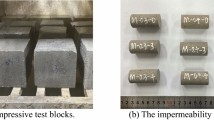Abstract
The water-repellent and anti-permeability properties of cement are crucial for the durability and safety of concrete structures. In this work, we prepared a hydrophobic Portland cement by using oleic acid as a modifier for fly ash and examined the properties of the cement paste samples. Fly ash was firstly reacted with oleic acid by the dry milling method, and the modified fly ash was used to prepare the hydrophobic Portland cement. The IR spectra confirmed that the surface of fly ash was successfully capped with oleic acid, and carboxylic acid moieties were bonded with ≡SiOH and neutralized. The TG-DSC results showed that the amount of oleic acid loaded on the fly ash beads was 7.21 wt%. Fly ash dispersed evenly in the prepared cement paste samples and the distance between beads ranged in 2–10 μm. The water contact angle of the cement paste samples increased with rising content of modified fly ash, which demonstrated good water-repellent behavior. Different cement sections showed similar water-repellent behavior, which proved that the inner structure of the cement was also hydrophobic. Using the fly ash modified with oleic acid significantly decreased the water uptake and gas permeability of the prepared cement paste samples. The hydrophobic cement sample was optimal when the content of the modified fly ash in the cement was 12 wt% and after the cement was cured for 28 days.







Similar content being viewed by others
References
Sychugov S, Tokarev Y, Plekhanova T, Mikhailova O, Pudov I, Faizullin R, Gaifullin A, Sagdiev R (2017) Line of approach to a problem of water resistance of anhydrite cements. Procedia Eng 172:982–990
Xue X, Yang J, Zhang W, Jiang L, Qu J, Xu L, Zhang H, Song J, Zhang R, Li Y (2015) The study of an energy efficient cool white roof coating based on styrene acrylate copolymer and cement for waterproofing purpose—Part I: optical properties, estimated cooling effect and relevant properties after dirt and accelerated exposures. Constr Build Mater 98:176–184
Lu Z, Zhou X, Zhang J (2004) Study on the performance of a new type of water-repellent admixture for cement mortar. Cem Concr Res 34:2015–2019
Saija LM (1995) Waterproofing of portland cement mortars with a specially designed polyacrylic latex. Cem Concr Res 25:503–509
Zhao FQ, Li H, Liu SJ, Chen JB (2011) Preparation and properties of an environment friendly polymer-modified waterproof mortar. Constr Build Mater 25:2635–2638
Zhang P, Liu Z, Han S, He L, Müller HS, Zhao T, Wang Y (2017) Visualization of rapid penetration of water into cracked cement mortar using neutron radiography. Mater Lett 195:1–4
Benbarek S, Bouiadjra BAB, Mokhtar BME, Achour T, Serier B (2013) Numerical analysis of the crack growth path in the cement mantle of the reconstructed acetabulum. Mater Sci Eng C Mater Biol Appl 33:543–549
Payá J, Monzó J, Borrachero MV, Velázquez S (2013) Cement equivalence factor evaluations for fluid catalytic cracking catalyst residue. Cem Concr Compos 39:12–17
Kobayashi K, Ahn DL, Rokugo K (2016) Effects of crack properties and water-cement ratio on the chloride proofing performance of cracked SHCC suffering from chloride attack. Cem Concr Compos 69:18–27
Qiu J, Tan HS, Yang EH (2016) Coupled effects of crack width, slag content, and conditioning alkalinity on autogenous healing of engineered cementitious composites. Cem Concr Compos 73:203–212
Popescu H, Simion A (1988) Thkermoanalytical study on some flim-forming quick-drying and waterproof products. Thermochim Acta 134:243–249
Ramli M, Tabassi AA (2012) Effects of polymer modification on the permeability of cement mortars under different curing conditions: a correlational study that includes pore distributions, water absorption and compressive strength. Constr Build Mater 28:561–570
Zhang H (2011) Building materials in civil engineering. Science Press, Beijing, pp 68–70
Fernández-Jiménez A, Palomo A (2003) Characterisation of fly ashes. Potential reactivity as alkaline cements ☆. Fuel 82:2259–2265
Hong SW, Barakat R, Alhilali A, Saleh M, Cheeseman CR (2015) Hydrophobic concrete using waste paper sludge ash. Cem Concr Res 70:9–20
Kulkarni GR (2012) Study of Fourier transform infrared spectra of cockroach nervous tissue and chitin. In: Proceedings of SPIE, vol 8221. The International Society for Optical Engineering, p 20
Liu P, Wang Q, Li X, Zhang C (2009) Investigation of the states of water and OH groups on the surface of silica. Colloids Surf A 334:112–115
Zeng G, Holladay S, Langlois D, Zhang Y, Liu Y (2013) Kinetics of heterogeneous reaction of ozone with linoleic acid and its dependence on temperature, physical state, RH, and ozone concentration. J Phys Chem A 117:1963–1974
Pacheco-Torgal F, Castro-Gomes J, Jalali S (2008) Alkali-activated binders: a review: Part 1. Historical background, terminology, reaction mechanisms and hydration products. Constr Build Mater 22:1305–1314
Fritzsche J, Peuker UA (2014) Particle adhesion on highly rough hydrophobic surfaces: the distribution of interaction mechanisms. Colloids Surf 459:166–171
Onda T, Shibuichi S, Satoh N, Tsujii K (1996) Super-water-repellent fractal surfaces. Langmuir 12:2125–2127
Oxtoby DW, Freeman WA, Block TF (1990) Chemistry: science of change. Suanders College Publishing, Philadelphia
Marmur A (2003) Wetting on hydrophobic rough surfaces: to be heterogeneous or not to be? Langmuir 19:8343–8348
Marmur A (2004) The lotus effect: superhydrophobicity and metastability. Langmuir ACS J Surf Colloids 20:3517–3519
Acknowledgements
This work is funded by the National Natural Science Foundation of China (No. 51461135005) and National Science & Technology Pillar Program during the twelfth Five-year Plan Period (No. 2014BAB15B01).
Author information
Authors and Affiliations
Corresponding author
Ethics declarations
Conflict of interest
The authors declare no conflict of interest.
Electronic supplementary material
Below is the link to the electronic supplementary material.
Rights and permissions
About this article
Cite this article
Liu, P., Feng, C., Wang, F. et al. Hydrophobic and water-resisting behavior of Portland cement incorporated by oleic acid modified fly ash. Mater Struct 51, 38 (2018). https://doi.org/10.1617/s11527-018-1161-8
Received:
Accepted:
Published:
DOI: https://doi.org/10.1617/s11527-018-1161-8




